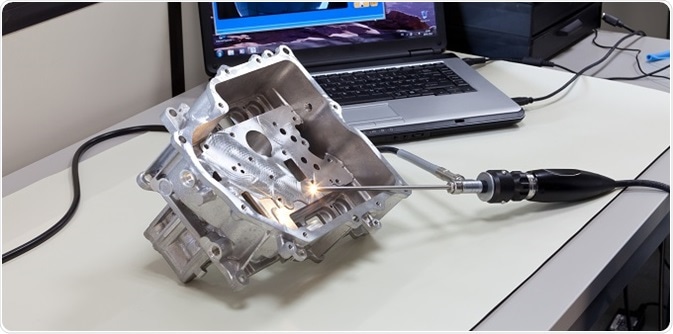Biophotonics is the science of producing and utilizing photons or light to image, identify, and engineer biological materials. It is the integration of four major technologies: biotechnology, lasers, photonics, and nanotechnology. Biomedical applications of biophotonics include light interactions in medicine and biology for the purposes of health care.
Diagnostic biophotonics
Diagnostic biophotonics is used to detect diseases in their initial stages before actual medical symptoms occur in patients. By using optics, diagnostic biophotonics provides several advantages of sensing and imaging at the molecular level and also collects multidimensional data for evaluation. Technologies based on light are generally contact-free with less effect on integrity of living subjects and, consequently, can easily be applied in situ.
- Optical tagging: Proteins, cells, DNA, and tissues are tagged with optical tags and their incandescence or fluorescence is measured; also, according to the pathological or physiological situation the changes are analyzed.
- Visualization of complex structures: Advanced laser technology has enhanced imaging of vasculature retinal structures and other optic nerves to provide precise diagnosis of ocular diseases. By observing the modifications occurring in ocular capillaries, the diagnosis of common vascular disorders is enabled.
- Cellular level diagnosis: Sophisticated optical technologies involving lasers, and photonic and biophotonic applications in medicine provide assistance in observing and identifying cellular biochemistry and their functions, organ integrity, and the characteristics of tissues.
- Optical endoscopes: In medical applications, the combination of optical fibers and endoscopes is used for less invasive imaging and surgery of internal organs. Laser light with high-level intensity is delivered using an optical fiber to an inner region of the body, for instance, to eradicate tumors.

© Thomas Klee/Shutterstock.com
Therapeutic biophotonics
Applications of light include treatment of diseases by altering biological processes. Light is used for modifying the cellular functions photochemically and to remove tissues by photomechanical or photothermal process.
- Thermal contact: In this method, heat is produced by high-energy laser light, which is used to disrupt the tissues and, hence the main impact of laser light is photothermal. The response to laser light of the target tissue depends on the extent of increase in temperature and water content in that specific tissue.
- Bioimaging: This is noninvasive imaging technique that visualizes real-time biological processes. This technique aims at lowering the impact of cellular processes as much as possible. Through bio-imaging, the ion or metabolite levels of molecular processes are quantified. Latest developments in bio-imaging include fluorescence resonance energy transfer and two-photon fluorescence excitation microscopy. Images that are reconstructed in both 2D and 3D have enhanced the effective visualization of disease processes and models.
- Photobiostimulation: The process of activating live cells or organisms by laser radiation is known as biostimulation. Low intensity laser and light emitting diode are broadly used in various aspects by dermatologists, dentists, and surgeons. These laser radiations are low powered and do not generate heat that can disrupt biological tissues. They promote a curing effect by deep penetration into the tissues, enabling progression of the photochemical effect.
- Optical coherence tomography (OCT): This method can offer label-free high resolution optical imaging with higher sampling frequency of intraoperative evaluation. OCT is a fast developing technology with the ability to influence many fields of human biology and clinical medicine. It is analogous to ultrasound in which reflected light is detected instead of sound. It can be used in the functioning of optical biopsies by generating images that are similar to histological sections without any removal or blotting of tissues. OCT is used potentially in the study of various tumors and is also applied as intraoperative surgery in breast cancer.
Applications in the field of research
Research in biophotonics aims at improving the sensing and optical imaging techniques to study the structure and function of cells or tissue at the microscopic and nanoscopic levels.
- Spectroscopy: Spectroscopy deals with the study of relation between emitted energy and matter. An electromagnetic radiation is a spectrum that is emitted or absorbed by a sample. This has been classified into various types such as fluorescence, infrared, ultraviolet, nuclear magnetic resonance, absorption, and mass spectroscopy. Raman spectroscopy is a scattering method based on Raman effect. In Raman scattering, the energy difference produces a molecular vibrational excitation.
- Photomechanics: Photomechanical analyses are based on optics used to study the gradient properties in biological materials. It is also used for examining the relationship between the mechanical stress and strain in the structure of root dentin. Light sensitive particles in polymer solutions or solids will undergo a conversion from light to mechanical energy called photo contraction.
- Fiber optic sensors: This technique deals with remote sensing of physical and chemical specifications. By focusing light into the central part and directing to a sample, analytical information is obtained. The optical signals are reflected back across the same fibers and the intensity is calculated. It is broadly accepted in detecting clinical and biochemical analytes, e.g., metabolites, immunoproteins, enzymes, and serum electrolytes. Sensors that react to these parameters are often called biosensors.
Further Reading